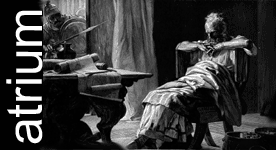Italy and Greece should take note ... from the Times:
A photo of the little hound accompanies the original article.
Members of the public unearthed 57,566 ancient objects last year, according to the British Museum — an increase of 45 per cent on 2005. The items included a spectacular Viking hoard of 20 silver bracelets.
Two reports published yesterday show how finds by people walking, gardening, farming or actively searching for treasure provide a wealth of information about our past.
David Lammy, the Culture Minister, described metal detector users as “the unsung heroes of the UK’s heritage”.
The Treasure Act 1996 requires the reporting of all gold and silver objects more than 300 years old, and groups of coins that are more than 300 years old and found on the same site.
The number of treasure cases has risen from 79 in 1997 to 506 in 2004, according to the Treasure Annual Report by the Department for Culture, Media and Sport. This has led to a huge increase in the material offered to local museums. The second report was by the Portable Antiquities Scheme, a voluntary scheme managed by the British Museum to record archaeological objects found in England and Wales.
Neil MacGregor, director of the British Museum, said that museums across Britain were acquiring important material. He said: “This huge increase in finds is testimony to the success of the Treasure Act and the Portable Antiquities Scheme and makes a crucial contribution to our understanding of our past.”
The bracelets were discovered by Steve Reynoldson, a metal detector user in Huxley, Cheshire, and reported to his local finds liaison officer.
They belong to an Hiberno- Scandinavian type produced in Ireland during the second half of the 9th century and the first half of the 10th.
Barry Ager, curator of the British Museum’s early medieval collection, said: “This is a very significant find, one of the largest hoards found outside Scandinavia or Russia.”
Although mostly complete, the bracelets had been folded in half and flattened — perhaps because the bullion was to be used in trade or as payment for military service.
The hoard is all the more significant for having possible associations with the famous hoard from Cuerdale, Lancashire, deposited around AD905 and held by the British Museum. The two hoards may have formed part of the same war chest or could be booty.
The British Museum said that the burial of both hoards for safekeeping suggested a troubled period when the Vikings, driven outby the Irish, settled in the Wirral, Lancashire and Cumbria in the early 10th century.
The find was valued at £28,000 and jointly acquired by National Museums Liverpool, the Grosvenor Museum in Chester and Cheshire Museums Service, with the help of the Heritage Lottery Fund.
Also unveiled yesterday was a charming 4th-century Roman copper-alloy figurine of a hound — possibly a votive gift — found in Newchurch on the Isle of Wight, by Alan Rowe, using a metal detector. He told The Times that he went searching for treasure twice a month. He was surprised to find the Roman artefact because he had searched the same site ten years earlier, unearthing Iron Age objects.
He believes the hound may have risen closer to the surface because rabbits had dug up a corner of the field. The piece is valued at about £600 and he hopes to sell it to the local museum.
A photo of the little hound accompanies the original article.
